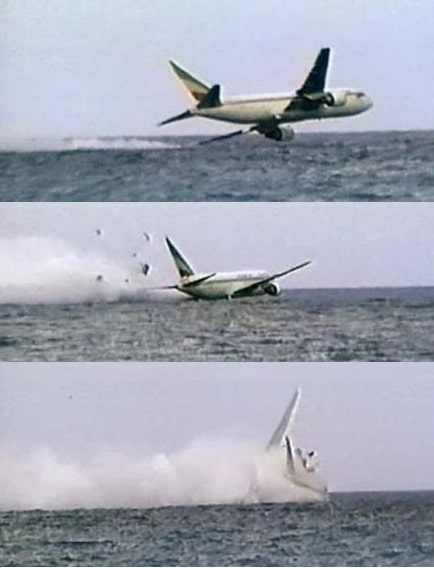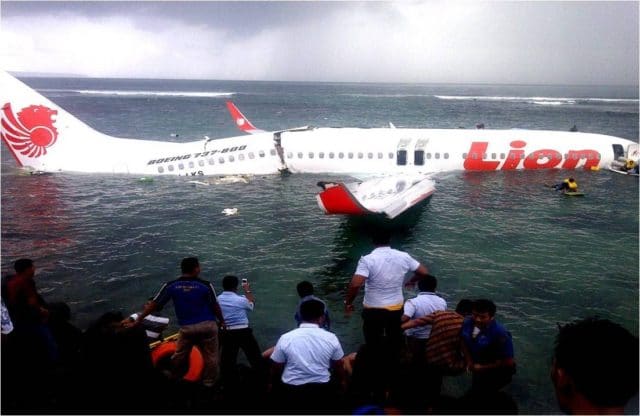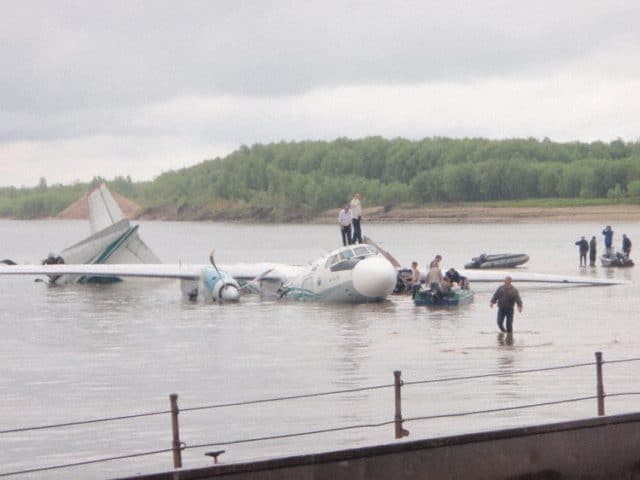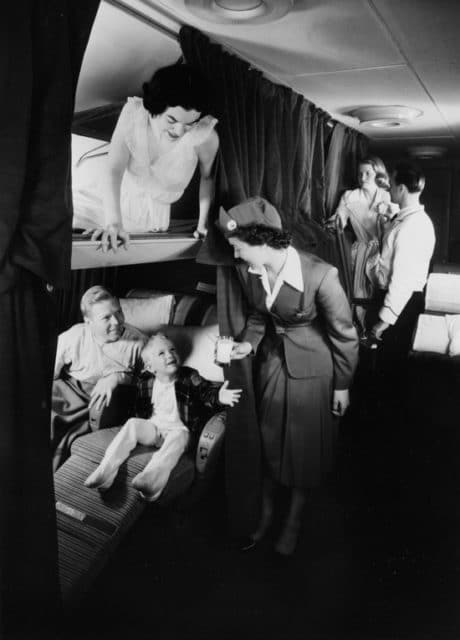How Many Successful Ditchings of Commercial Airliners?
When I was learning to fly, I remember someone in the pilots’ bar insisting that all that talk about life jackets under your seat was a waste of time; if your aircraft is going down over water, you were done for.
This wasn’t just idle talk. In 1999, Slate’s article In The Event of a Water Landing said that ditchings are virtually nonexistent and virtually nonsurvivable, claiming that there had never been a single ditching by a US-flag commercial airline but “several non-US airlines have experienced ditchings, with mixed results”. The US does not have a single flag-carrying airline, instead all US carriers on a type 401 certificate are considered to be U.S. flag air carriers. It simply means the airline is US based.
The article goes on to quote the Aviation Consumer Action Project, which says that
in an attempted water landing, a wide body jet would “shatter like a raw egg dropped on pavement, killing most if not all passengers on impact, even in calm seas with well-trained pilots and good landing trajectories.
In 2002, The Economist published an article about pilotless planes which stated as fact that “no large airliner had ever made an emergency landing on water” and that the life jackets were only there to make passengers feel better.
(Presumably the “ditch” button is only in the Airbus cockpit to make the pilots feel better.)
This is blatantly untrue but when I tried to look up successful ditchings, I found a lot of varied information. What I couldn’t find was a reliable number of exactly how many successful commercial airliner ditchings there have been in the history of aviation.
Now, there’s no end of lists on the internet but they all disagree, sometimes even with themselves.
- Aviation Safety Network lists 312 occurrences with a result of Emergency, forced landing – Ditching. There’s no way to limit this to only commercial flights but it is certainly immediately obvious that US-based passenger aircraft have been ditching since the 1930s.
-
Wikipedia’s Water Landing page states in the first paragraph that there have been nine intentional commercial airliner ditchings and then goes on to list twenty examples, where Ethiopian 961 is listed both as a planned and as an unplanned water ditching.
-
Meanwhile, Wikipedia’s Emergency Landing page claimed that there were only eight 8 intentional ditchings, a list which has since been removed.
-
AirSafe.com Jet airliner Ditching Events, the most commonly cited list, gives only four ditching events but it is clear that they are limiting their list to passenger jet airliner services. I’m not sure why one would be specific about jet airliners; it seems an odd restriction to me.
-
Skybrary’s article on Ditching: Fixed Wing Aircraft doesn’t give a number but offers four examples.
-
In an academic paper Review of Transport Aircraft Ditching Accidents, a compilation of all known planned ditching events of passenger transport jet aircraft, six ditching events are named.
Note: all of these lists include the “Miracle on the Hudson”, the United US Airways Airlines Airbus A320-200 landing in the Hudson after a bird strike. All but the AirSafe.com page (which to be fair doesn’t claim to be an exhaustive list) also mention Ethiopian Airlines flight 961 which attempted to ditch near Grande Comore island after being hijacked; however it impacted at high speed and tumbled, breaking into three pieces.

Part of the problem is varying definitions. Wikipedia specifies “intentional commercial airliner ditchings” which seems fair enough, but AirSafe only lists jet airliners, which seems an arbitrary restriction. In 2006, another Economist article We’re about to crash claimed that “in the history of aviation the number of wide-bodied aircraft that have made successful landings on water is zero”, limiting their definition to wide bodies… but even so, in 1993, there were two incidents of Boeing 747s which overshot the runway and landed on water. Did they mean successful ditching events? Probably, but that’s not what they said. Besides, I think I could make a case for the Boeing 377 Stratocruiser being a wide-body, but I’ll get back to that.
It seems to me that the first thing we need to do is agree on the definitions.
What do we mean by successful?
I think as a starting point, we can say that a successful ditching is one with no or very few fatalities. Forget the aircraft: in the event of an emergency over water, the focus is on the survival. In the case of Ethiopian 961, only 25 of the 175 souls on board survived. I think we can agree that was not a successful ditching. I’m not sure if there are any borderline cases but I’m happy to think harder about this if one comes up.
What do we mean by commercial airliner?
Strictly speaking, this is an aircraft which transports passengers and air cargo as a commercial service. It gets a bit fuzzy because, in general conversation, I think that we are more likely to envisage a Boeing 737 than a six-seater Cessna 402.
What do we mean by ditching?
In principle, ditching refers to an aircraft attempting a forced landing on water. But clearly, not every emergency water landing can be considered ditching: sea planes and standard aircraft with floats land on water all the time. During the first half of the 20th century, international passenger flights landed on water as standard, as large distances needed large aircraft and large aircraft needed long runways, which mostly didn’t exist. For their around-the-world flights, Pan Am used flying boats, known as Clippers, which would land in the bay of their destination and then motor to the harbour to drop off the passengers and cargo. In the case of an emergency, the flight crew would be looking for protected water for their emergency landing just as a land-based plane would be looking for a field.
Thus, it seems to me that only aircraft which are not meant to land on water can ditch, else it’s either a forced landing or a crash. I have to admit, though, I’m now wondering if there are any successful incidents of a sea plane carrying out a forced landing on dry land.
Going back to the topic at hand, more obvious is that to ditch an aircraft, it must be an intentional water landing. Despite my sarcastic comment above, I think it is clear that a runway overrun into water should not be included in a list of successful ditchings. I don’t think that “control of the aircraft” is a good way of defining this. An aircraft which inadvertently impacts the water is not ditching, it is crashing. So that includes, for example, Aeroperú 603 and Air France 447, where the flight crew effectively had control of the aircraft but inadvertently flew into the water. I don’t think anyone would think of those as unsuccessful ditchings.

How deep is the water?
This is one I hadn’t thought about until I started looking at specific incidents.
Wikipedia’s list at one point included a Yak-40 incident in June 1976 (in Russian) as a ditching but the aircraft actually landed on a flood-meadow, and, according to one commenter, it was actually quite dry at the time.
In Why Planes Crash Casefiles: 2002 I wrote about the ditching of Garuda flight 421, which landed on the Bengawan Solo River in Indonesia. But in retrospect, the aircraft sank only a few feet before coming to rest on the muddy riverbed.
Similarly, some of the above lists include Angara Airlines flight 9007, an Antonov An-24 passenger flight which suffered an engine fire during a domestic flight. The crew made a decision to ditch in the Ob River and although the flight crew were killed on impact, 30 of the remaining 35 on board were rescued. But the footage of the accident show people standing in the shallow water next to the aircraft.

I wouldn’t dare say that water landings on a river shouldn’t count as ditching but it does seem reasonable to define the water as being deep enough that the survivors can’t walk to shore.
There’s another successful “ditching” which bothers me: Japan Airlines flight 2, which landed in the San Francisco Bay in 1968. It was a jet and no one was seriously injured, let alone killed, when the aircraft landed in the Bay. In fact, the aircraft, a DC-8, was back in service within a year! However, it fails on the criterion of ‘intentional’: it was an overcast and foggy day and the flight crew did not mean to land in the water. They meant to land on the runway at San Francisco and became disoriented, attempting to land the plane two and a half miles early. So although the NTSB called it ‘the first successful ditching of a jetliner’, the fact is, the flight crew didn’t intend to land in the bay which makes it more correctly an inadvertent water landing.
(Supposedly, when the captain was asked how it happened, he replied, “As you Americans say, I fucked up.”)
Going back to the Economist claim that there’s never been a successful ditching, I’ve concluded that actually, the first successful commercial ditching was in 1956: Pan Am flight 6.
Although the airline referred to it as a clipper named Sovereign of the Skies, the aircraft was not one of Pan Am’s flying boats but a Boeing 377 Stratocruiser meant to land on runways. The Boeing 377 is referred to as a “large body” but with beds in a 2 by 2 configuration, I think it would qualify as a wide body if passengers were packed in as tightly as they are today.

More importantly, the flight crew intentionally ditched the aircraft and it was undoubtedly successful: everyone on board was rescued.
Flying from Honolulu to San Francisco during its around-the-world tour, the Sovereign of the Skies suffered an overspeeding propeller and an engine failure. The flight crew declared an emergency, making contact with the US Coast Guard cutter Pontchartrain. Then, using the remaining three piston engines, they circled until daybreak until they could ditch next to the cutter. The aircraft and rescue were filmed from the Pontchartrain and it’s amazing to watch:
I did find one media reference to this as the first ditching in Traveller:
When aircraft disappear, more than two-thirds of the time they are flying over water, said James Stabile, the vice president of Aeronautical Data Systems, which developed a program that lets pilots know what ships are below them. And in the handful of cases in which an airliner landed in the water and no one died – like Flight 6 and US Airways Flight 1549 in the Hudson in 2009 – boats were on the scene immediately.
So now the real question is: how many were there in between?








I’d say a “commercial airliner” describes any flight that is operated by an “Airline Transport Pilot (ATP)” (or whatever the comparable designation was at the time). This would exclude your 6-seater, and would also exclude ferry flights with no passengers. (I think this also rules out military flights.)
Given the cartwheeling flight 961, I’d consider any ditching on a water surface, regardless of the depth of the water; but it would be interesting to find out how many aircraft have ditched in open waters (oceans) as opposed to ditching inland. The “Miracle on the Hudson” was not on open water.
Whether a ditching is successful depends on the perspective: for whoever survives, the ditching was a success. I’m also in two minds how to account for the rescue effort: if you manage to set the aircraft down unharmed, but the rescue is delayed, then the pilot ditched successfully even though the passengers may not have been able to be rescued in time.
I’d say a ditching is a landing on water undertaken as a response to an in-air emergency of some sort that forced a landing on a body of water by an aircraft not designed to operate that way.
I’d be interested in any events where air transport pilots managed to ditch their air transports in one piece (mostly) in open water that were followed by successful rescues (such as Pan Am flight 6), and events where pilots managed to do that inland but where the rescue effort failed badly.
This article starts with the question of life jackets so I’d think the criteria for whether an accident is relevant is whether or not the life jackets were useful.
E.g., in the case of the Ethiopian 961 hijack I’d guess that at least some of the 25 survivors were injured or couldn’t swim so, though rescue came quite quickly, presumably life jackets contributed to their survival.
Sadly in the case of Ethiopian 961 lifejackets appear to have contributed to some of the deaths. The aircraft had been hijacked and the flight crew were unable to give a proper briefing due to interference by the hijackers. It was reported that some passengers inflated their life jackets before exiting the aircraft and, as the water level rose inside the cabin, were then unable to get out. I thought more survived and a quick gander at several web sources all say there were 50 survivors which is, I think, quite remarkable given the circumstances.
This is quite a jigsaw puzzle with many pieces that don’t seem to fit smugly together. No, a complete picture does not emerge easily here. Let me have a go at it.
What is a “commercial airliner”? In my book, a commercial airliner is an aircraft that is operating for the carriage of passengers or cargo for hire and reward, on an AOC: an Airline Operations Certificate. In the USA this means under FAR 401, not FAR 25. It also means that for this type of operations, aircraft are normally used that require a cockpit crew of two qualified pilots – for extended operations extra relief pilots – under IFR. The captain should be the holder of an ATPL, in some countries the second officer should at least have passed the theoretical examinations for that licence. Aircraft such as a Cessna 402 or a Bandeirante would not qualify as an “airliner”, even if they have been used for commercial air transport. OK, I am making this up as a I go along a bit, but what is “ditching”? In my opinion, this means landing an aircraft, other than a seaplane or flying boat, on a surface consisting of water.
I used the word “landing”. Sylvia already made clear that “ditching” means putting the aircraft down on water under some form of control, in an attempt to touch down in a manner intended to avoid or at least reduce injuries or loss of life.
The word “intentional” was used by Sylvia. Debatable: unless it was the result of a hijack or a terrorist act, the intention only comes into play when the crew conclude that they have no other option.
A crash on water, not under control of the crew, is not “ditching”.
The Ethiopian 961 accident was an unsuccessful ditching, but Lionair 904 and Air France 447 were crashes. Yes, the Lionair 737 was under some form of control, but the pilots were not trying to land on water in an attempt to save lives. They flew an extremely sloppy approach if I remember correctly. The Air France crew incorrectly interpreted the readings of their instruments, and were not coordinating their actions until it was too late.
In 1954 a KLM Super Constellation, destination New York, crashed immediately after take-off from Shannon Airport. These heavy piston-engine airliners needed all the power they had in order to get airborne safely. For take-off a power setting was used that had to be reduced to METO – Maximum Except Take-Off – power as soon as the aircraft was in the air in order to limit excess strain on the engines. Unfortunately, just after the power was reduced to METO by the flight engineer, the landing gear was inadvertently extended and the aircraft lost altitude. There was not enough time to raise the wheels again. The captain tried to remain airborne but he lost too much speed. The aircraft entered a stall, they landed in the Shannon river. This was a crash rather than a ditching. The FE managed to swim ashore and alerted the authorities. It took several hours for S&R to reach the crash site.
I agree with Sylvia: the Boeing Stratocruiser can be considered to have been the “wide-bodied airliner” of its period.
Airbus Industries later operated a few with an enlarged fuselage of extended diameter, called the “Pregnant Guppy” or “Super Guppy”, designed to transport fuselage sections for the A300 between the Airbus plants, e.g. Toulouse and Hamburg Finkenwerder. The whole front section, including the cockpit, was hinged. The front section would be supported by an extra strut and swung outwards.
I have actually witnessed the failure of a hinge with the nose section open. The single strut could support, but not stabilise it and the entire nose section fell sideways on the tarmac.
Well, there would have been ample structural engineering capability to fix it, but it is not likely that it would fly that day.
Two incidents come to mind for me, both were ditchings of large aircraft without fatalities. The first was a demonstration flight of a Bristol Britannia which caught fire and landed in the Severn Estuary. This probably doesn’t qualify as the ditching was on mud flats. The second was a successful ditching of an RAF Nimrod again after a fire on board, this too probably doesn’t count as the aircraft was in military service, although the Nimrod was a derivative of the DH Comet of the late 1940s. In both these cases the position of the engines must have helped.
An interesting thought, by convention aircraft always ‘land’ and never ‘water’. Those are the only options aren’t they?
If you consider a space shuttle-type craft an aircraft (since it is able to maneouver aerodynamically), “go into orbit” is a third possibility. ;-)
An aircraft setting down on a carrier is a landing on water.
Zeppelins would be tethered and not land.
And then there was a time when you could land an aircraft in the air (Wikipedia):
Calling an aircraft landing on the flight deck of an aircraft carrier a “landing on water” is not going to work. Especially since naval aircraft really do sometimes land on water when they ditch (most of my reading about “ditching” has been in the context of naval aircraft, e.g., running out of fuel before they can reach their carriers). And an aircraft landing on a frozen lake is not landing “on water”, either, even though there’s probably liquid water under the ice — it’s landing on ice.
As for “parasite fighters” — which are admittedly quite strange (I think some of the Soviet Zveno Project examples are even weirder than things like the USS Akron) — I think “docking” is probably a better description of what they’re doing.
Although this discussion states that it deals with the ditching of commercial airliners, I would consider including the Nimrod mentioned by Adam Brook.
Mendel has a few interesting exceptions too.
The space shuttle, interesting: is it an aircraft? I guess it is, but it is not an “airliner”.
A carrier landing: Not an “airliner”, and the expanse of metal that separates it from the sea means that we still call the touchdown a “landing”. In many cases this resulted in a crash into the water.
Zeppelins, rigid airships and Blimps: yes they are tethered. The ground crews would assist the “landing”, after which the airship would be tethered with the nose to a mooring pole. This would allow the airship to act as a wind vane, swinging around in case the wind were to change direction. If this were not the case and a strong wind would spring up the airship could sustain serious damage, even be blown away.
It takes quite a lot of hydrogen and a long time to fill it, and helium is expensive. Don’t forget: an airship is lighter than air. When moored, a lot of ballast would be attached to keep it on the ground.
But yes, hesitantly, but I would call it a landing.
And with a bit of imagination, an airship could be classified as an “airliner” even though their success has been marred by accidents.
The Hindenburg disaster was the most known, especially as there were film crews filming the arrival. But the British had their own airships, like the R100 and the ill-fated R101.
Interestingly, the name “Zeppelin” has become synonymous with rigid airships, although the name was adopted from the German airship, the “Graf Zeppelin”. The R100 and R!01 were therefore strictly speaking not “Zeppelins”. The American navy developed a semi-rigid airship for anti-submarine patrols. The final version became known as the B type Limp airship, or the Blimp. There were ribs in the front and aft sections of the envelope, a bit like the ribs of an umbrella, and a frame to support the cabin and engine pods but the envelope itself was inflated and kept its shape by the internal pressure of the gas. It was therefore vulnerable to precipitation, especially snow which, if heavy enough, could change the shape of the envelope and force it down.
Experiments have been made, catching an aircraft in mid-air. I guess Mendel refers to that. The Sparrowhawk was not very successful. But eventually, it had to come down and again, they were not “airliners”.
I think in the case of Japan Airlines flight 2, while one can argue that it wasn’t, technically, an instance of “ditching” (in the intentional sense), it is worth mentioning as a clear refutation of things like the Aviation Consumer Action Project’s claim — i.e., jet airliners clearly can successfully land on water without killing most or all of the passengers. (Indeed, one could argue that if airliners can survive accidentally landing on water, they can probably survive intentionally landing on water more easily…)
Hah, that’s a very good point!
In the paragraph directly above the Ethiopian photoset, you say the “Miracle on the Hudson” was a United A320—it was US Airways.
Ouch! So I did. Fixed and thank you for that!
Wikipedia claims that several Short Sunderland flying boats were intentionally landed on grass airfields during WWII, because their hulls were sufficiently damaged that they’d sink if landed in water. One was apparently repairable and flew again.
Clearly it is possible for a plane (of whatever category or size) to ditch on water with a large proportion of the passengers surviving. That proportion will depend on the angle and speed of landing (pilot skills) but also things outside the crew’s control such as wave height and wind gusts (or crazy hijackers trying to seize control of the yoke – Ethiopian).
I guess the further question is how many finally survive out of the initial survivors? Again that will depend on many factors, such as orderly and rapid evacuation (cabin crew control), good notification to ATC/rescuers (pilot control), but probably most of all things that are outside anyone’s control: location of ditching (a mid-ocean ditching in the north Atlantic is very different to a close-in coastal ditching in the Mediterranean), ambient temperature (ditto), and wave height. Landing in heavy waves will likely sink the aircraft very quickly.
We all hope never to be in that scenario :-o